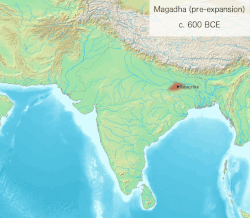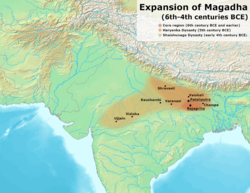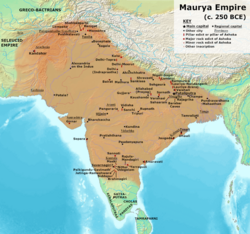Magadha
Magadhaalso called theKingdom of Magadhaor theMagadha Empire,was akingdomandempire,and one of the sixteenMahajanapadas,'Great Kingdoms' of theSecond Urbanization,based in southernBiharin theeastern Ganges Plain,inAncient India.Magadha was ruled by theBrihadratha dynasty(1700-682 BCE), thePradyota dynasty(682-544 BCE), theHaryanka dynasty(544–413 BCE), theShaishunaga dynasty(413–345 BCE), theNanda dynasty(345–322 BCE), theMauryan dynasty(322–184 BCE), theShunga dynasty(184–73 BCE),Kanva dynasty(73–28 BCE) andGupta Empire(240-550 CE).Kanva dynastylost much of its territory after being defeated by theSatavahanasofDeccanin 28 BCE and was reduced to a small principality aroundPataliputra.[2][3]However, with the rule ofGupta Empire(240-550 CE), The Gupta Empire regained the Glory of Magadh. Under theMauryas,Magadha became a pan-Indian empire, covering large swaths of theIndian subcontinentandAfghanistan.TheMagadhunder theGupta Empireemerged as the most prosperous Kingdom in the History of Ancient India.
Magadha played an important role in the development ofJainismandBuddhism.[4]It was the core of four of northern India's greatest empires, theNanda Empire(c. 345– c. 322 BCE),Maurya Empire(c. 322–185 BCE),Shunga Empire(c. 185–78 BCE) andGupta Empire(c. 240–550 CE). ThePala Empirealso ruled over Magadha and maintained a royal camp inPataliputra.[5][6]
ThePithipatis of Bodh Gayareferred to themselves asMagadhādipatiand ruled in parts of Magadha until the 13th century.[7]
Geography[edit]



The territory of the Magadha kingdom proper before its expansion was bounded to the north, west, and east respectively by theGaṅgā,Son,andCampārivers, and the eastern spurs of theVindhya mountainsformed its southern border. The territory of the initial Magadha kingdom thus corresponded to the modern-dayPatnaandGayadistricts of the Indian state ofBihar.[8]
The region ofGreater Magadhaalso included neighbouring regions in the eastern Gangetic plains and had a distinct culture and belief. Much of theSecond Urbanisationtook place here from (c. 500 BCE) onwards and it was here thatJainismand Buddhism arose.[9][failed verification]
History[edit]

Some scholars have identified theKīkaṭatribe—mentioned in theRigveda(3.53.14) with their ruler Pramaganda—as the forefathers ofMagadhasbecause Kikata is used as synonym for Magadha in the later texts;[10]Like the Magadhas in the Atharvaveda, the Rigveda speaks of the Kikatas as a hostile tribe, living on the borders of Brahmanical India, who did not perform Vedic rituals.[11]
The earliest reference to the Magadha people occurs in theAtharvaveda,where they are found listed along with theAngas,Gandharisand Mujavats. The core of the kingdom was the area of Bihar south of theGanges;its first capital was Rajagriha (modernday Rajgir), thenPataliputra(modernPatna). Rajagriha was initially known as 'Girivrijja' and later came to be known as so during the reign ofAjatashatru.Magadha expanded to include most of Bihar andBengalwith the conquest ofVajjika LeagueandAnga,respectively.[12]The kingdom of Magadha eventually came to encompassBihar,Jharkhand,Orissa,West Bengal, easternUttar Pradesh,and the areas that are today the nations ofBangladeshandNepal.[13]
The ancient kingdom of Magadha is heavily mentioned inJainandBuddhist texts.It is also mentioned in theRamayana,theMahabharataand thePuranas.
There is little certain information available on the early rulers of Magadha. The most important sources are the BuddhistPāli Canon,theJain Agamasand the HinduPuranas.Based on these sources, it appears that Magadha was ruled by theHaryanka dynastyfor some 200 years, c. 543 to 413 BCE.[14]
Gautama Buddha,the founder ofBuddhism,lived much of his life in the kingdom of Magadha. He attained enlightenment inBodh Gaya,gave his first sermon inSarnathand thefirst Buddhist councilwas held inRajgriha.[15]
The HinduMahabharatacallsBrihadrathathe first ruler of Magadha. Ripunjaya, last king of Brihadratha dynasty, was killed by his minister Pulika, who established his son Pradyota as the new king.Pradyota dynastywas succeeded byHaryanka dynastyfounded byBimbisara.Bimbisara led an active and expansive policy, conquering the Kingdom ofAngain what is nowWest Bengal.KingBimbisarawas killed by his son,Ajatashatru.Pasenadi,king of neighbouringKosalaand brother-in-law of Bimbisara, promptly reconquered the Kashi province.
Accounts differ slightly as to the cause ofKing Ajatashatru's warwith theLicchavi,a powerful tribe north of the riverGanges.It appears that Ajatashatru sent a minister to the area who worked for three years to undermine the unity of the Licchavis. To launch his attack across the Ganges River, Ajatashatru built a fort at the town ofPataliputra.Torn by disagreements, the Licchavisfought with Ajatashatru.It took fifteen years for Ajatashatru to defeat them. Jain texts tell how Ajatashatru used two new weapons: a catapult, and a covered chariot with swinging mace that has been compared to a modern tank. Pataliputra began to grow as a centre of commerce and became the capital of Magadha after Ajatashatru's death.
The Haryanka dynasty was overthrown by theShishunaga dynasty.The last Shishunaga ruler,Mahanandin,was assassinated byMahapadma Nandain 345 BCE, the first of the so-called "Nine Nandas", i. e. Mahapadma and his eight sons, last beingDhana Nanda.
In 326 BCE,the army of Alexander approachedthe western boundaries of Magadha. The army, exhausted and frightened at the prospect of facing another giant Indian army at the Ganges, mutinied at the Hyphasis (the modernBeas River) and refused to march further east. Alexander, after the meeting with his officerCoenus,was persuaded that it was better to return and turned south, conquering his way down the Indus to the Ocean.
Around 321 BCE, the Nanda Dynasty ended with the defeat of Dhana Nanda at the hands ofChandragupta Mauryawho became the first king of theMauryan Empirewith the help of his mentorChanakya.The Empire later extended over most of India under KingAshoka The Great,who was at first known as 'Ashoka the Cruel' but later became a disciple of Buddhism and became known as 'DharmaAshoka'.[16][17]Later, the Mauryan Empire ended, as did theShungaandKhārabēḷaempires, to be replaced by theGupta Empire.The capital of the Gupta Empire remained Pataliputra in Magadha.
During the Pala-period in Magadha from the 11th to 13th century CE, a local Buddhist dynasty known as thePithipatis of Bodh Gayaruled as tributaries to Pala Empire.[7]
Buddhism and Jainism[edit]
SeveralŚramaṇic movementshad existed before the 6th century BCE, and these influenced both theāstika and nāstikatraditions of Indian philosophy.[18]TheŚramaṇa movementgave rise to diverse range of heterodox beliefs, ranging from accepting or denying the concept of soul, atomism, antinomian ethics, materialism, atheism, agnosticism, fatalism to free will, idealization of extreme asceticism to that of family life, strictahimsa(non-violence) and vegetarianism to the permissibility of violence and meat-eating.[19]Magadha kingdom was the nerve centre of this revolution.
Jainismwas revived and re-established afterMahavira,the last and the 24thTirthankara,who synthesised and revived the philosophies and promulgations of the ancient Śramaṇic traditions laid down by the first Jain tirthankaraRishabhanathamillions of years ago.[20]BuddhafoundedBuddhismwhich received royal patronage in the kingdom.


According to IndologistJohannes Bronkhorst,the culture of Magadha was in fundamental ways different from the Vedic kingdoms of theIndo-Aryans.According to Bronkhorst, theśramanaculture arose in "Greater Magadha,"which was Indo-Aryan, but notVedic.In this culture,Kshatriyaswere placed higher thanBrahmins,and it rejectedVedicauthority and rituals.[9][21]He argues for a cultural area termed "Greater Magadha",defined as roughly the geographical area in which theBuddhaandMahaviralived and taught.[9][22]
With regard to the Buddha, this area stretched by and large fromŚrāvastī,the capital ofKosala,in the north-west toRājagṛha,the capital of Magadha, in the south-east ".[23]According to Bronkhorst "there was indeed a culture of Greater Magadha which remained recognizably distinct from Vedic culture until the time of the grammarian Patañjali (ca. 150 BCE) and beyond".[24]The Buddhologist Alexander Wynne writes that there is an "overwhelming amount of evidence" to suggest that this rival culture to the Vedic Aryans dominated the eastern Gangetic plain during the early Buddhist period. Orthodox Vedic Brahmins were, therefore, a minority in Magadha during this early period.[25]
The Magadhan religions are termed thesramanatraditions and includeJainism,BuddhismandĀjīvika.Buddhism and Jainism were the religions promoted by the early Magadhan kings, such as Srenika,BimbisaraandAjatashatru,and theNanda Dynasty(345–321 BCE) that followed was mostly Jain. These Sramana religions did not worship theVedic deities,practised some form ofasceticismandmeditation(jhana) and tended to construct round burial mounds (calledstupasin Buddhism).[24]These religions also sought some type of liberation from the cyclic rounds of rebirth and karmic retribution through spiritual knowledge.
Religious sites in Magadha[edit]
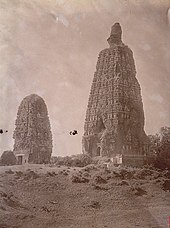
Among the Buddhist sites currently found in the Magadha region include two UNESCOWorld Heritage Sitessuch as theMahabodhi templeatBodh Gaya[26]and theNalandamonastery.[27]The Mahabodhi temple is one of the most important places of pilgrimage in the Buddhist world and is said to mark the site where the Buddha attained enlightenment.[28]
Language[edit]
Beginning in the Theravada commentaries, thePali languagehas been identified withMagahi,the language of the kingdom of Magadha, and this was taken to also be the language that the Buddha used during his life. In the 19th century, the BritishOrientalistRobert Caesar Childersargued that the true or geographical name of the Pali language wasMagadhi Prakrit,and that becausepāḷimeans "line, row, series", the early Buddhists extended the meaning of the term to mean "a series of books", sopāḷibhāsāmeans "language of the texts".[29]Nonetheless, Pali does retain some eastern features that have been referred to asMāgadhisms.[30]
Magadhi Prakrit was one of the three dramatic prakrits to emerge following the decline of Sanskrit. It was spoken in Magadha and neighbouring regions and later evolved into modern easternIndo-Aryan languageslikeMagahi,MaithiliandBhojpuri.[31]
Dynasties and rulers[edit]
The history of Magadha region is very vast, it can be divided into many periods as:
- Vedic Magadha Kingdom:-Kikata Kingdom,Brihadratha dynasty
- Magadha Mahajanapada:-Pradyota dynasty,Haryanka dynasty,Shaishunaga dynasty
- Magadha Empire:-Nanda Empire,Maurya Empire,Shunga Empire,Kanva dynasty
- Classical Magadha:-Gupta Empire,Later Gupta dynasty
- Medieval Magadha:-Pala Empire,Pithipatis of Bodh Gaya
There is much uncertainty about the succession of kings and the precise chronology of Magadha prior to Mahapadma Nanda; the accounts of various ancient texts (all of which were written many centuries later than the era in question) contradict each other on many points.
Two notable rulers of Magadha wereBimbisara(also known asShrenika) and his sonAjatashatru(also known asKunika), who are mentioned in Buddhist and Jain literature as contemporaries of the Buddha and Mahavira. Later, the throne of Magadha was usurped byMahapadma Nanda,the founder of theNanda Dynasty(c. 345– c. 322 BCE), which conquered much of north India. The Nanda dynasty was overthrown byChandragupta Maurya,the founder of theMaurya Empire(c. 322–185 BCE).
Furthermore, there is a "Long Chronology" and a contrasting "Short Chronology" preferred by some scholars, an issue that is inextricably linked to the uncertainchronology of the BuddhaandMahavira.[32] According to historianK. T. S. Sarao,a proponent of the Short Chronology wherein the Buddha's lifespan was c.477–397 BCE, it can be estimated that Bimbisara was reigning c.457–405 BCE, and Ajatashatru was reigning c.405–373 BCE.[33] According to historianJohn Keay,a proponent of the "Long Chronology," Bimbisara must have been reigning in the late 5th century BCE,[34]and Ajatashatru in the early 4th century BCE.[35]Keay states that there is great uncertainty about the royal succession after Ajatashatru's death, probably because there was a period of "court intrigues and murders," during which "evidently the throne changed hands frequently, perhaps with more than one incumbent claiming to occupy it at the same time" until Mahapadma Nanda was able to secure the throne.[35]
List of rulers[edit]
The following "Long Chronology" is according to the BuddhistMahavamsa:[36]
- Haryanka dynasty(c. 544– 413 BCE)
| Ruler | Reign (BCE) |
|---|---|
| Bimbisara | 544–491 BCE |
| Ajatashatru | 491–461 BCE |
| Udayin | 461–428 BCE |
| Anirudha | 428–419 BCE |
| Munda | 419–417 BCE |
| Darshaka | 417–415 BCE |
| Nāgadāsaka | 415–413 BCE |
- Shishunaga dynasty(c. 413– 345 BCE)
| Ruler | Reign (BCE) |
|---|---|
| Shishunaga | 413–395 BCE |
| Kalashoka | 395–377 BCE |
| Kshemadharman | 377–365 BCE |
| Kshatraujas | 365–355 BCE |
| Nandivardhana | 355–349 BCE |
| Mahanandin | 349–345 BCE |
- Nanda Empire(c. 345– c. 322 BCE)
| Ruler | Reign (BCE) |
|---|---|
| Mahapadma Nanda | 345–340 BCE |
| Pandhukananda | 340–339 BCE |
| Panghupatinanda | 339–338 BCE |
| Bhutapalananda | 338–337 BCE |
| Rashtrapalananada | 337–336 BCE |
| Govishanakananda | 336–335 BCE |
| Dashasidkhakananda | 335–334 BCE |
| Kaivartananda | 334–333 BCE |
| Karvinathanand | 333–330 BCE |
| Dhana Nanda | 330–322 BCE |
Other lists[edit]
TheHindu LiteraturemostlyPuranasgive a different sequence:[37]
- Shishunaga dynasty (360 years)
- Shishunaga (reigned for 40 years)
- Kakavarna (36 years)
- Kshemadharman (20 years)
- Kshatraujas (29 years)
- Bimbisara (28 years)
- Ajatashatru (25 years)
- Darbhaka or Darshaka or Harshaka (25 years)
- Udayin (33 years)
- Nandivardhana (42 years)
- Mahanandin (43 years)
- Nanda dynasty (100 years)
- List byJain literature
A shorter list appears in the Jain tradition, which simply lists Shrenika (Bimbisara), Kunika (Ajatashatru), Udayin, followed by the Nanda dynasty.[37]
Historical figures from Magadha[edit]
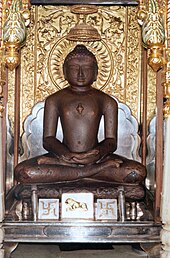
Important people from the region of Magadha include:
- Śāriputra– born to a wealthyBrahminin a village located nearRājagahain Magadha. He is considered the first of the Buddha's two chief male disciples, together withMaudgalyāyana.[38]
- Maudgalyāyana– born in the village of Kolita in Magadha. He was one of the Buddha's two main disciples. In his youth, he was a spiritual wanderer before meeting the Buddha.[39]
- Mahavira– the 24thTirthankaraofJainism.Born into a royalkshatriyafamily in what is nowVaishali districtofBihar.He abandoned all worldly possessions at the age of 30 and became an ascetic. He is considered a slightly older contemporary of the Buddha.[40]
- Maitripada– an 11th-century Indian BuddhistMahasiddhaassociated with theMahāmudrātransmission. Born in the village of Jhatakarani in Magadha. Also associated with the monasteries ofNalandaandVikramashila.[41]
- Dhyānabhadra- 13th/14th century monk ofNalandaborn to a minor chief in Magadha and later travelled across South and East Asia.[42]
- Subhūticandra- 11/12th-century Indian Buddhist monk associated withNalandaandVikramashilawho belonged to Magadha.[43]
See also[edit]
- Mahajanapadas
- History of India
- Magadha-Vajji war
- Magadha-Anga war
- Avanti-Magadhan Wars
- List of Indian monarchs
- Timeline of Indian history
- Magahi Culture
- Magahi Languages
Notes[edit]
- ^as described in theArthashastra
References[edit]
- ^Jain, Dhanesh (2007)."Sociolinguistics of the Indo-Aryan languages".In George Cardona; Dhanesh Jain (eds.).The Indo-Aryan Languages.Routledge. pp. 47–66, 51.ISBN978-1-135-79711-9.
- ^Keny, Liladhar (1943). ""THE SUPPOSED IDENTIFICATION OF UDAYANA OF KAUŚĀMBI WITH UDAYIN OF MAGADHA"".Annals of the Bhandarkar Oriental Research Institute.24(1/2): 60–66.JSTOR41784405.
- ^Roy, Daya (1986). "SOME ASPECTS OF THE RELATION BETWEEN ANGA AND MAGADHA (600 B.C.—323 B.C.)".Proceedings of the Indian History Congress.47:108–112.JSTOR44141530.
- ^Damien Keown (26 August 2004).A Dictionary of Buddhism.OUP Oxford. p. 163.ISBN978-0-19-157917-2.
- ^Jhunu Bagchi (1993).The History and Culture of the Pālas of Bengal and Bihar, Cir. 750 A.D.-cir. 1200 A.D.Abhinav Publications. p. 64.ISBN978-81-7017-301-4.
- ^Jha, Tushar; Tyagi, Satish (2017). "CONTOURS OF THE POLITICAL LEGITIMATION STRATEGY OF THE RULERS OF PALA DYNASTY IN BENGAL- BIHAR (CE 730 TO CE 1165)".Proceedings of the Indian History Congress.78:49–58.
- ^abBalogh, Daniel (2021).Pithipati Puzzles: Custodians of the Diamond Throne.British Museum Research Publications. pp. 40–58.ISBN9780861592289.
- ^Raychaudhuri, Hemchandra(1953).Political History of Ancient India: From the Accession of Parikshit to the Extinction of Gupta Dynasty.University of Calcutta.pp. 110–118.
- ^abcBronkhorst 2007,p.[page needed].
- ^Macdonell, Arthur Anthony; Keith, Arthur Berriedale (1995).Vedic Index of Names and Subjects.Motilal Banarsidass Publishers.ISBN9788120813328.
- ^M. Witzel. "Rigvedic history: poets, chieftains, and polities,"inThe Indo-Aryans of Ancient South Asia: Language, Material Culture and Ethnicity.ed. G. Erdosy (Walter de Gruyer, 1995), p. 333
- ^Ramesh Chandra Majumdar (1977).Ancient India.Motilal Banarsidass Publ.ISBN81-208-0436-8.
- ^Sinha, Bindeshwari Prasad (1977).Dynastic History of Magadha, Cir. 450–1200 A.D.Abhinav Publications. p. 128.
- ^Chandra, Jnan (1958). "Some Unknown Facts About Bimbisāra".Proceedings of the Indian History Congress.21:215–217.JSTOR44145194.
- ^"Lumbini Development Trust: Restoring the Lumbini Garden".Archived fromthe originalon 6 March 2014.Retrieved6 January2017.
- ^Tenzin Tharpa,Tibetan Buddhist Essentials: A Study Guide for the 21st Century: Volume 1: Introduction, Origin, and Adaptation,p.31
- ^Sanjeev Sanyal (2016),The Ocean of Churn: How the Indian Ocean Shaped Human History,section "Ashoka, the not so great"
- ^Ray, Reginald (1999).Buddhist Saints in India.Oxford University Press. pp. 237–240, 247–249.ISBN978-0195134834.
- ^Jaini, Padmanabh S. (2001).Collected papers on Buddhist Studies.Motilal Banarsidass. pp. 57–77.ISBN978-8120817760.
- ^Patel, Haresh (2009).Thoughts from the Cosmic Field in the Life of a Thinking Insect [A Latter-Day Saint].Strategic Book Publishing. p. 271.ISBN978-1-60693-846-1.
- ^Long, Jeffery D. (2009).Jainism: an introduction.London: I.B. Tauris.ISBN978-1-4416-3839-7.OCLC608555139.
- ^Witzel, Michael (1997). "Macrocosm, Mesocosm, and Microcosm: The Persistent Nature of 'Hindu' Beliefs and Symbolic Forms".International Journal of Hindu Studies.1(3): 501–539.doi:10.1007/s11407-997-0021-x.JSTOR20106493.S2CID144673508.
- ^Bronkhorst 2007,pp. xi, 4.
- ^abBronkhorst 2007,p. 265.
- ^Wynne, Alexander (2011)."Review of Bronkhorst, Johannes, Greater Magadha: Studies in the Culture of Early India".H-Buddhism.Retrieved25 August2019.
- ^K.T.S. Sarao (16 September 2020).The History of Mahabodhi Temple at Bodh Gaya.Springer Nature. pp. 66–.ISBN9789811580673.
- ^Pintu Kumar (7 May 2018).Buddhist Learning in South Asia: Education, Religion, and Culture at the Ancient Sri Nalanda Mahavihara.Le xing ton Books.ISBN978-1-4985-5493-0.
- ^David Geary; Matthew R. Sayers; Abhishek Singh Amar (2012).Cross-disciplinary Perspectives on a Contested Buddhist Site: Bodh Gaya Jataka.Routledge. pp. 18–21.ISBN978-0-415-68452-1.
- ^A Dictionary of the Pali LanguageBy Robert Cæsar Childers
- ^Rupert Gethin (9 October 2008).Sayings of the Buddha: New Translations from the Pali Nikayas.OUP Oxford. pp. xxiv.ISBN978-0-19-283925-1.
- ^Beames, John (2012).Comparative Grammar of the Modern Aryan Languages of India: To Wit, Hindi, Panjabi, Sindhi, Gujarati, Marathi, Oriya, and Bangali.Cambridge: Cambridge University Press.doi:10.1017/cbo9781139208871.003.ISBN978-1-139-20887-1.
- ^Bechert, Heinz(1995).When Did the Buddha Live?: The Controversy on the Dating of the Historical Buddha.Sri Satguru Publications. p. 129.ISBN978-81-7030-469-2.
- ^Sarao, K. T. S. (2003),"The Ācariyaparamparā and Date of the Buddha.",Indian Historical Review,30(1–2): 1–12,doi:10.1177/037698360303000201,S2CID141897826
- ^Keay, John (2011).India: A History.Open Road + Grove/Atlantic. p. 141.ISBN978-0-8021-9550-0.
- ^abKeay, John (2011).India: A History.Open Road + Grove/Atlantic. p. 149.ISBN978-0-8021-9550-0.
- ^Bechert, Heinz (1995).When Did the Buddha Live?: The Controversy on the Dating of the Historical Buddha.Sri Satguru Publications.ISBN978-81-7030-469-2.
- ^abGeiger, Wilhelm; Bode, Mabel Haynes (25 August 1912)."Mahavamsa: the great chronicle of Ceylon".London: Pub. for the Pali Text Society by Oxford Univ. Pr. – via Internet Archive.
- ^Prasad, Chandra Shekhar (1988)."Nalanda vis-à-vis the Birthplace of Śāriputra".East and West.38(1/4): 175–188.JSTOR29756860.
- ^Gunapala Piyasena Malalasekera (2007).Dictionary of Pāli Proper Names.Motilal Banarsidass Publishers. pp. 403–404.ISBN978-81-208-3022-6.
- ^Romesh Chunder Dutt (5 November 2013).A History of Civilisation in Ancient India: Based on Sanscrit Literature: Volume I.Routledge. pp. 382–383.ISBN978-1-136-38189-8.
- ^Tatz, Mark (1987). "The Life of the Siddha-Philosopher Maitrīgupta".Journal of the American Oriental Society.107(4): 695–711.doi:10.2307/603308.JSTOR603308.
- ^Buswell, Robert; Lopez, Donald (2014).The Princeton Dictionary of Buddhism.Princeton University Press. p. 1056.ISBN9780691157863.
- ^Deokar, Lata (2012)."Subhūticandra: A Forgotten Scholar of Magadha".Journal of the Centre for Buddhist Studies, Sri Lanka.10:137–154.
Sources[edit]
- Raychaudhuri, H.C. (1972).Political History of Ancient India.Calcutta: University of Calcutta.
- Law, Bimala Churn (1926)."4. The Magadhas".Ancient Indian Tribes.Lahore: Motilal Banarsidas.
- Bronkhorst, Johannes (2007).Greater Magadha: studies in the culture of early India(PDF).Handbook of oriental studies. Section two, India. Vol. 19. Leiden; Boston: Brill.ISBN978-90-04-15719-4.ISSN0169-9377.OCLC608455986.Archived fromthe original(PDF)on 11 September 2015.
- Singh, Upinder(2016),A History of Ancient and Early Medieval India: From the Stone Age to the 12th Century,Pearson,ISBN978-81-317-1677-9
- Magadha
- Ancient empires and kingdoms of India
- Historical Indian regions
- History of Bihar
- Iron Age cultures of South Asia
- Mahajanapadas
- Jain empires and kingdoms
- Regions of Bihar
- Kingdoms of Bihar
- 4th-century BC disestablishments in India
- Magahi language
- Empires and kingdoms of Nepal
- Former kingdoms
- Kingdoms in the Mahabharata
- Regions of Jharkhand


